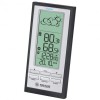Meade TE388W User Manual - Page 5
Battery Installation, Mounting, Placement, Operation
 |
View all Meade TE388W manuals
Add to My Manuals
Save this manual to your list of manuals |
Page 5 highlights
BATTERY INSTALLATION NOTE: When the temperature falls below freezing point 32°F (0°C), battery voltage will drop which may result in reduced the transmission range. For optimum in cold conditions, we recommend using lithium batteries. NOTE: Install the batteries and select the channel before mounting the remote sensor. • Remove the screws from the battery compartment with a small Phillips screwdriver (not included). • Set the channel 1 through 3. The switch is located in the battery compartment. Channel 1 is typically selected if only one remote sensor is being used. • Install 2 "AA" size alkaline batteries (not included) matching polarity as shown in the battery compartment. • Replace the battery compartment door and secure the screws. • Secure the remote sensor in the desired location. MOUNTING • The remote sensor can be mounted either horizontally or vertically. • Use a screw, rather than a nail, to securely mount the sensor. • When mounting the main unit on a vertical surface, fold the built-in table stand back into the unit, allowing the main unit to lie flush with the surface. PLACEMENT • The remote sensor should be placed under eaves or a similar location with free air circulation sheltered from direct sunlight and extreme weather. • Ideally, place the remote sensor over soil, rather than asphalt which would cause false readings. • Avoid placing the remote sensor near sources of heat, such as chimneys and heating elements • Avoid areas that collect heat from the sun and radiate heat, such as metal, brick or concrete structures, paving, and patios • The international standard for the valid air temperature measurements is 4 feet (1.25meters) above the ground OPERATION Immediately after batteries are installed, the remote sensor will start transmitting a temperature data to the main unit. 5














